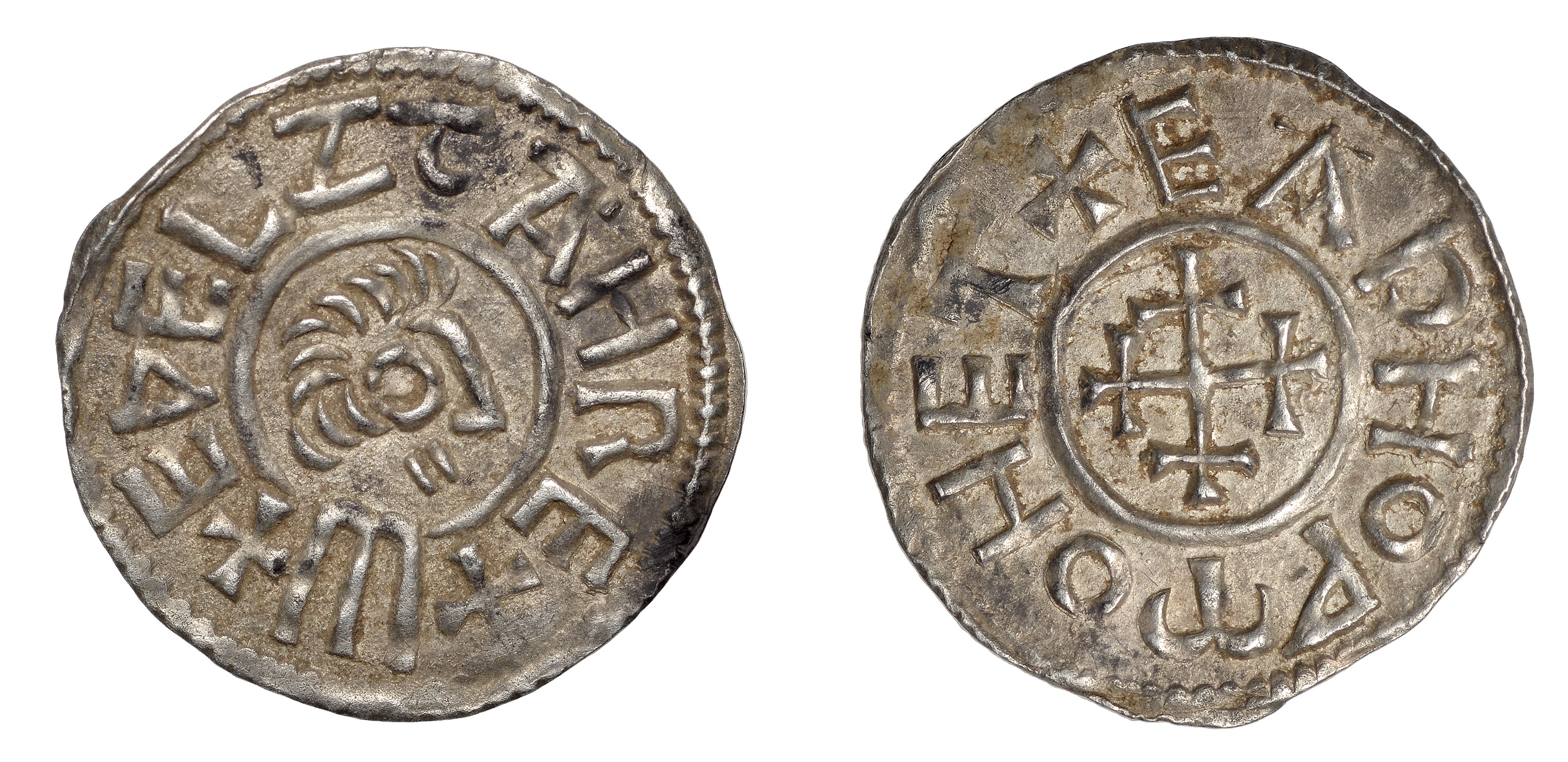Kings of East Anglia, Æthelstan (825-40), Penny, [Ipswich], Eadnoth, edelztan re+, draped bust right, breaking inner circle, rev. +eadnod monet around cross-crosslet, 1.28g/8h (Naismith E30a, same dies; SCBI BM 833, same dies; Pagan BNJ 1982, p. 58; N 434; S 948). Nearly extremely fine, struck on a full round flan, free from the usual porosity and retaining a light earthen patina consistent with being a field find; the third and finest known example of this excessively rare and attractive issue £8,000-£10,000 --- Provenance: Found near Amesbury (Wiltshire), 6 March 2022 (EMC 2022.0109) Naismith’s corpus records just two examples of Æthelstan portrait pennies struck by Eadnoth, from two obverse and two reverse dies. The present coin, which is seemingly only the third known example, was struck from the same dies as the coin now housed within the British Museum. It is the finest in terms of preservation. Æthelstan was a king of the independent Kingdom of East Anglia which emerged following the end of Mercian Supremacy in 825. Unfortunately, the paucity of contemporary written sources means that we know little about events in the region during the first half of the ninth century. The Anglo-Saxon Chronicle relates that in 825 the Mercian King Beornwulf, after his disastrous defeat at the battle of Ellendum against King Ecgberht of Wessex, was slain by an anonymous king of the East Angles. Beyond this, little interest was shown by the Chronicle’s compiler towards the East Anglian kings or their activities. This fact, coupled with a complete absence of surviving charters from the area, means that we must turn to the numismatic evidence for answers. The identity of the first independent king of East Anglia is made clear from the hoard record, with the Middle Temple hoard being particularly informative. The large group, deposited at some point during the 840s, contained 243 early ninth century coins produced under various kings across England. Included within were some 39 pieces of Æthelstan. No coins of any other independent East Anglian ruler were present, making Æthelstan’s primacy clear. The name Eadnoth, the moneyer responsible for the striking of the coin offered for sale here, first appears on pennies of the Mercian king Offa in the 780s and then on coins of the obscure local king Eadwald who usurped power in East Anglia for a brief period during the late eighth century. Following this Eadnoth signed no coins during the first two decades of the ninth century, despite the productive nature of the East Anglian mint under the supervision of the Mercian Kings Coenwulf and Ceolwulf. Finally the name reappears in c.824 on the coins of the last Mercian rulers to exercise power within the region, Beornwulf and Ludica, before continuing onto the coinage of the independent king Æthelstan. Given that several decades lapsed between these episodes of the minting activity we ought to consider the possibility that these are two different moneyers by the same name. Elsewhere, attempts have been made to detect familial connections between successive moneyers operating within the same area who share similar names. The case of Eadnoth may provide another good candidate for such a scenario, and it is possible that the Eadnoth who struck our coin was a relative, perhaps even a son, of Offa’s moneyer. In common with all of Æthelstan’s portrait coins, the present specimen was struck at the beginning of the monarch’s reign, as part of an issue that probably lasted until c. 830. Æthelstan portrait pennies were completely absent from the Middle Temple Hoard. From this some have inferred that these early coins must had dropped out of circulation by this point. However, the same hoard contained numerous pennies struck under Æthelstan’s Mercian predecessors, Coenwulf, Ceolwulf and Beornwulf. It is difficult to believe that all of Æthelstan’s portrait pennies ceased to circulate on account of wear, damage and loss whereas those of earlier rulers consistently did not. We should not dismiss the possibility that Æthelstan’s Portrait coinage was officially called in and deliberately withdrawn from circulation in a renovation monetae. Such a policy was seemingly employed by the Kings of Wessex during the second half of the Ninth century to help bring uniformity to their currency and led to a total absence of earlier coins in hoards deposited after the reform’s instigation. It is notable that following the short episode of iconographical variation early in Æthelstan’s reign all of the East Anglian coinage, continuing throughout the reigns of his successors Æthelweard and Eadmund, was of a generally consistent design. If such a reform was implemented it would help to explain why the portrait pennies of Æthelstan remain so excessively rare, despite the general increase in ninth century coins discovered and excavated over the previous two decades. Works cited Blunt, C.E., Lyon, C.S.S., and Stewart, B.H.I.H., 1963. ‘The coinage of southern England, 796–840’, BNJ 32, 1–74. Pagan, H.E., 1982. ‘The Coinage of the East Anglian Kingdom from 825 to 870’, BNJ 52, 41-83. Pagan, H.E., 1986. ‘Coinage in southern England, 796-874’ in M.A.S. Blackburn (ed), Anglo-Saxon Monetary History: Essays in memory of Michael Dolley (London), 45-66. Naismith, R., 2011. The Coinage of Southern England 796–865, BNS Special Publication 8, 2 vols. (London). Naismith, R., 2012. Money and Power in Anglo-Saxon England: the Southern English Kingdom 757-865 (Cambridge). Stenton, F., 1971. Anglo-Saxon England. Third Edition (Oxford).


